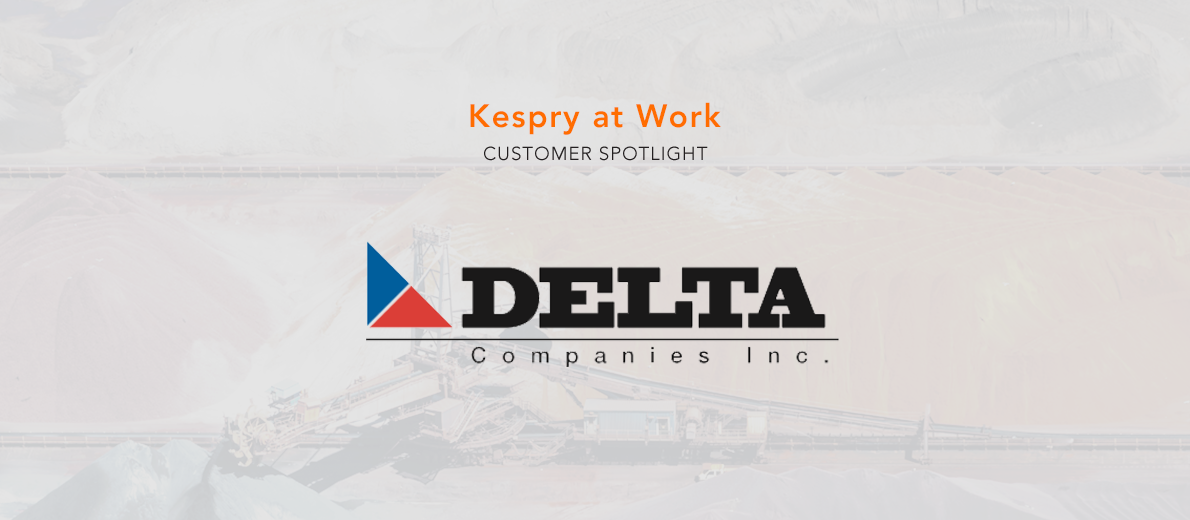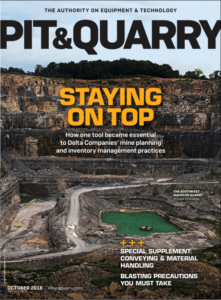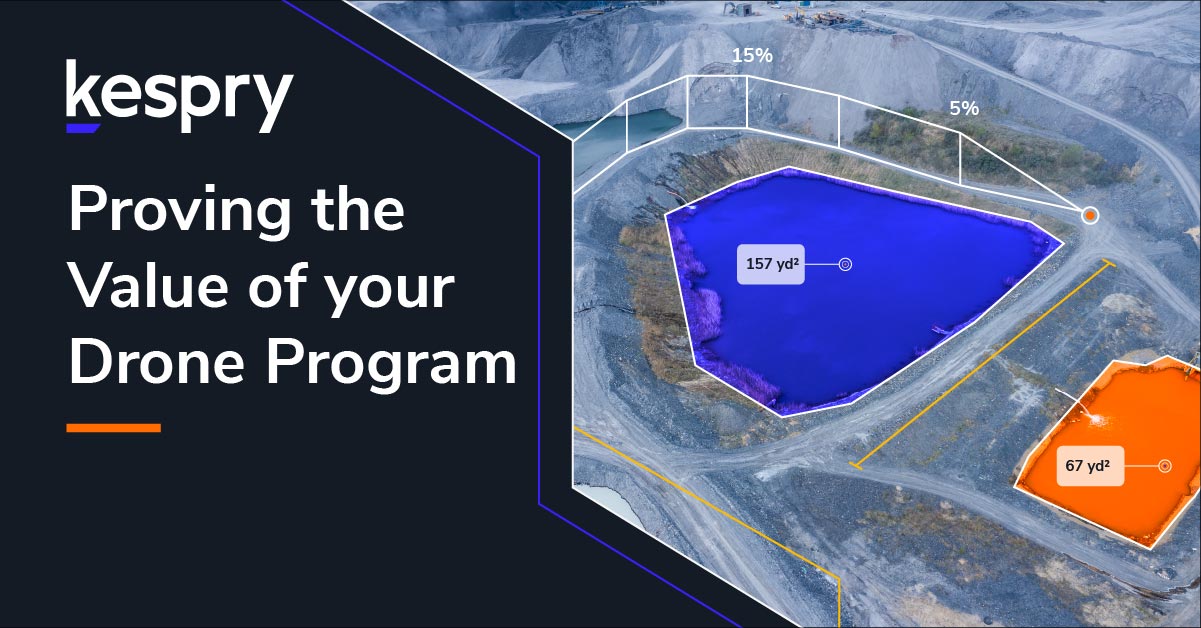An interview with Drew Hoover, Project Engineer, and Don Rosenbarger, Business Development Manager, at Delta Companies Inc.
Delta Companies Inc., one of the Colas USA subsidiaries, is a site development and highway contractor specializing in asphalt paving and road construction materials. The Company operates in southern Illinois, northeast Arkansas, and southeast Missouri, with its corporate office located in Cape Girardeau, Missouri. Delta is a technology leader and an innovator using a drone and analytics system to manage inventory. Delta was an early Kespry customer, and has seen the technology and capabilities evolve through upgraded systems and features.
Drew Hoover is the Project Engineer for the aggregates division at Delta Companies. He is responsible for mine planning, managing inventory stockpiles, and all details on major quarry projects from safety to contractor management. “I love seeing the progress the quarry makes over time – over a year, or even two or three years.” Drew says, “Looking back, I can see drone flights of the pit from 2016 through 2018. You can really see what has been removed, and what the millions of tons removed really looks like. Day to day changes are relatively small, but when you look at it from a year to year basis, it’s amazing how much changes in a quarry over that amount of time.”
Don Rosenbarger is the Business Development Manager for Delta Companies. He has responsibilities for innovation and growing the business. “I like seeing the growth in our people and how that results in the growth of our business.” Don says, “We do a lot of training to bring in somebody out of college and help them develop their skills and technical abilities and their overall experience and expertise in our business. And that certainly has direct results in our business growth. What I like most about my job is seeing our people learn and grow. We’ve got better managers, better workers, better employees, and better people. And I know that grows our business.”
Colas and Delta Companies strive to create the safest possible work environment in an industry with potentially significant danger. Drew has had the opportunity to provide training to others (students, teachers, and contractors) regarding the drone technology, featuring their Kespry system.
We talked with Drew and Don about their work with Kespry.
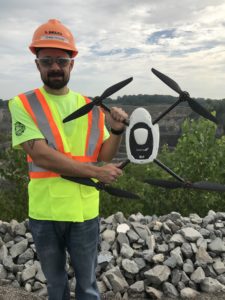
Drew Hoover with his Kespry Drone
From your various training opportunities, what was an example that you shared about using drones in mining to make your work safer?
Drew: The Kespry Drone keeps us away from high walls and big equipment. We have seventy-foot stockpiles in places. Without Kespry, we’d have a guy climbing on the stockpile with a survey rod trying to get the points he needs to accurately measure the stockpile and get all the different contours of the stockpile, versus the drone just flying over. There’s no risk to the drone rolling down the pile and breaking a leg or getting hit by a haul truck. I can set up and fly from a safe location as opposed to having to walk around and get points with a mobile GPS system.
Don: Our haul trucks carry 70 tons of material. The tires are taller than you standing on my shoulders. They can’t see anybody out there who may be surveying with a rod. They would never even feel it if they ran over you. So now, our drone pilot can sit at a safe location out of harm’s way. They’re secure. Everyone in the quarry knows where they are, so it’s just a safer endeavor. There’s a lot of activity going on with the trucks, the loaders, and blasting. And because of the size of the equipment moving around, you get hurt badly or you get killed.
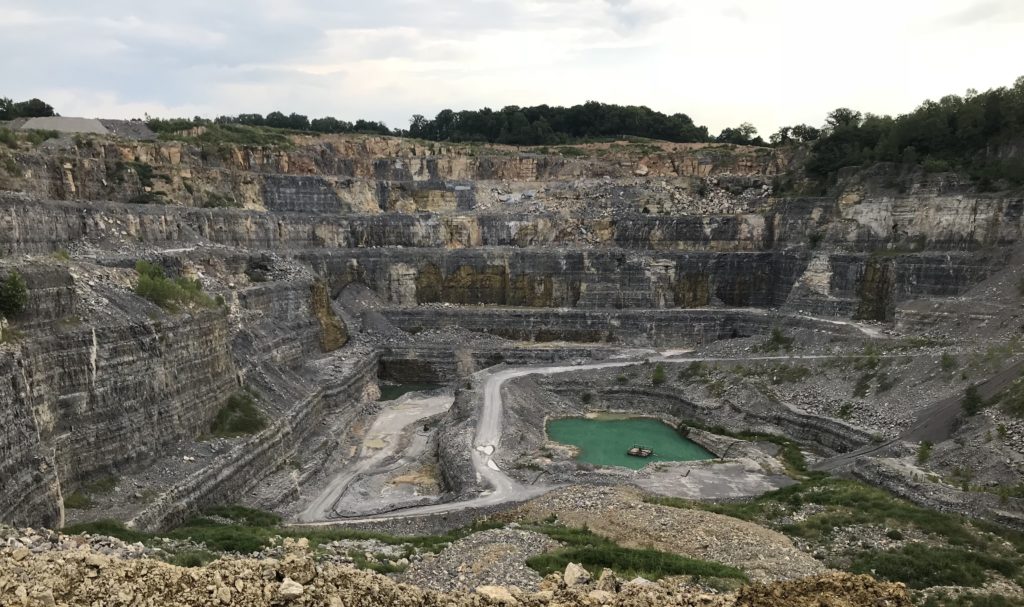
Delta Companies SEMO Quarry
How do you use Kespry for mine planning at Delta Companies?
Drew: We do large overburden removal projects yearly at our different quarries to open up reserve. I plan out how much we need to open up for reserves for each site each year. And then from that, I use Kespry images to determine planning from how much overburden we have to remove to managing the contractors doing the work safely and cost effectively. Another benefit is if we hit some unexpected, geological structures in the mine, I can fly the drone the same day and give us a picture of the pit, and an idea of what’s going on and where we need to go to get past it. The drone also gives the mine managers an updated picture of the mine. They can see their whole operation from their office and plan things out. It helps them plan their day-to-day activities. Even my annual mine plans can now be updated as often as necessary. The drone gives us a lot of additional tools and resources, with time and safety being two of them.
Don: Our large quarry in Cape Girardeau has 10 different ledges in it. That means there are 10 different qualities of the aggregate coming down through that quarry. If a particular project is in ledge number eight, or bench number eight, we can’t just go to bench number eight and take it. We’ve got to take all the product off the ones above that, so it’s critical that we understand exactly what is exposed, where those ledges are, and how much we need, so certainly the mine planning with the drone enables us to plan more efficiently. We’re not shooting a bench with a rod and level anymore. The drone goes in there and shoots it all for us.
How did you used to do mine planning before you had Kespry?
Drew: Before Kespry, the only way to do it was through an aerial flyover with a plane. That was a very expensive process. It’s not something that you could just do whenever you wanted, and there’s a good deal planning involved – such as waiting for a clear day for the plane to fly.
What is the benefit of using Kespry for stockpile management?
Drew: It really helps with accuracy. We can catch mistakes earlier. When we could only do inventory once or twice a year, if we found a huge discrepancy between the first and the last measurement, we had a big problem to resolve. Whereas tracking monthly, we can make the discrepancies much smaller, and we can catch them quickly because we know what’s actually there every month. It allows much more accurate inventory measurements.
Don: We’re very much into just in time inventory because there’s a huge amount of money sitting there in aggregate stockpiles. By knowing how much of each product we have, Kespry helps us do a better job of managing inventory because it’s all about managing cash. Kespry helps us on both sides, making sure we have product when it’s required, but making sure we don’t have too much product when it’s not required. Instead of us measuring stockpiles once a year like we used to, we now do it at least monthly. And if there’s a particular concern or question about a product, Drew has the ability to go fly it every day if he needs to do so.
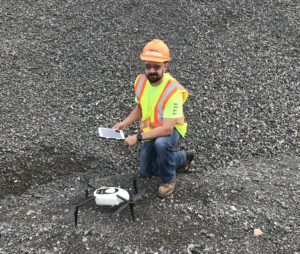
Drew measures stockpiles with the Kespry system
How did you measure stockpiles before you had Kespry?
Don: Before Kespry, to measure stockpile inventory, there was a gentleman out there walking with a survey rod and later with a GPS backpack and he had to physically stab every point on the pile to get the results. And that took weeks, if not a month, to do. And now we can get all that same information in a couple days.
How does accurate inventory management benefit your sales team?
Don: The Kespry information is shared with our managers and sales people responsible for our various quarries. We never want to make a commitment that we cannot honor. That’s one of our core values. With integrity, we say what we mean, and we mean what we say. So if we tell you that we’ve got product, we have it. If we tell you we don’t, we don’t have it.
How do you manage your reporting to Colas, and is Kespry helping with that?
Drew: When I do the inventory reports, I fly the site and mark the polygons to get the volumes. Each type of material has a SKU number, an inventory number, on our Kespry Cloud. I send the Kespry pdf volume report to the mine manager to make sure their piles are labeled correctly. The accountants reconcile the numbers to the drone, and that becomes our new inventory value of what is actually there to report to Colas.
How long would that reporting have taken you before Kespry, and how is it better now?
Drew: Before Kespry, inventory measurement, might have taken us a month. We’re a lot more accurate now because the window is much smaller. Before, it might take two or three days to measure at a site, but a lot happens in two or three days. More product goes on the pile. More product comes off the pile. So there is always some speculation, or assumptions that are made. But with the drone, I’m taking the measurement at 1:00, and in between 1:00 and 1:15 or 1:30, it’s done. So now we only have a 15- to 30-minute period where products are coming on the pile and products are leaving the pile, so it’s much more accurate and that allows the whole reporting process to reduce in time, and increase in accuracy.
Don: Now our managers and accountants, instead of waiting six weeks to get stockpile measurements, they’re getting them within a week. And that just speeds everything up. It makes everybody feel much more comfortable.
Read the feature article in Pit & Quarry about Delta’s success with Kespry in inventory management and mine planning.
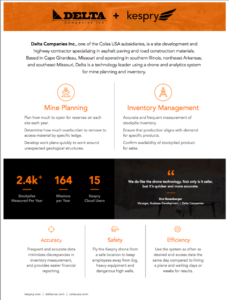 Check out the highlights summary in the Delta Companies Case Study.
Check out the highlights summary in the Delta Companies Case Study.

